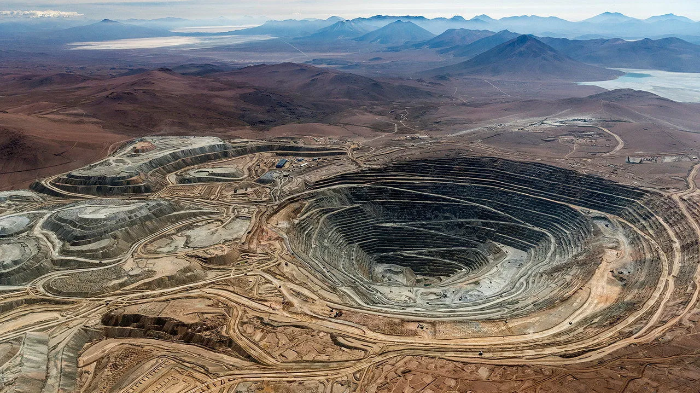
In a recent interview, Hudbay Minerals CEO Peter Kukielski stated that he believes that BHP Group’s recently rejected $39 billion offer for Anglo American has increased the value of copper assets. This could signal a growing willingness among large miners to pay a premium for existing copper mines, and spark a potential bidding war.
Hudbay plans to initiate a formal sale process later this year for a minority stake in its Arizona Copper World project. The company has already engaged in preliminary discussions with interested parties.
Copper Demand and Prices
BHP’s offer for Anglo American, though ultimately rejected, highlights the industry’s focus on copper. Three-month copper prices on the London Metal Exchange recently peaked above $10,200 a metric ton, driven by expected demand for the metal in electrification technologies.
Hudbay’s Copper World project is currently under construction and projected to produce an average of 92,000 metric tons of copper annually over its first ten years. Phase 1 development has an estimated cost of C$1.3 billion ($950.6 million). Kukielski indicated that Hudbay will look for joint-venture partners once necessary permits have been obtained.
Canadian Miners as Targets
Analysts see Canadian copper miners as potential acquisition targets due to a global shortage of new copper mines. Hudbay itself has been active in domestic acquisitions, purchasing Copper Mountain last year for C$439 million. However, RBC Capital Markets has also suggested Hudbay could become a takeover target if copper prices decline.
BHP Group Ltd.’s proposed £31.1 billion ($38.8 billion) takeover of Anglo American aimed to create a mining giant with significantly increased copper production. The all-share deal would have required Anglo to first spin off its controlling interests in South African platinum and iron ore companies. Anglo American rejected the offer, deeming it an undervaluation.
A BHP-Anglo combination would have given BHP roughly 10% of the world’s copper mine supply. Market watchers anticipate a significant copper supply shortage, which is expected to drive prices higher. This deal, while unsuccessful, could spark interest from other major miners looking to increase their copper exposure.
Anglo American, with attractive South American copper operations, has been a long-considered takeover target. However, its complex structure involving commodities like platinum and diamonds, along with its significant South African holdings, has deterred potential suitors.
Anglo American has recently faced setbacks due to price drops in some of its key commodities and operational challenges. These factors have contributed to a decline in its valuation, potentially increasing its vulnerability to takeovers.
The BHP-Anglo proposal, despite its rejection, suggests a return to mega-deals in the mining sector after a decade of cautious activity. With larger cash reserves and a renewed focus on investor confidence, the industry appears ready for a potential wave of mergers and acquisitions.
Commodities giant Glencore is also reportedly considering an approach to acquire Anglo American, according to two sources familiar with the matter. This development suggests a potential bidding war could emerge for the 107-year-old mining company.
Discussions within Glencore are in preliminary stages, and it remains uncertain whether the company will formally approach Anglo with an offer. However, Glencore’s interest comes on the heels of BHP Group’s recently rejected $39 billion all-stock takeover proposal.
BHP May Still Be in the Running
A source familiar with BHP’s plans previously indicated that the Australian mining giant is exploring an improved offer for Anglo American. BHP has until May 22nd to make a formal bid, suggesting the company may remain in contention.
Anglo American’s appeal lies primarily in its prized Chilean and Peruvian copper assets. Demand for copper is projected to surge due to its widespread applications in electric vehicles, renewable energy infrastructure, and expanding AI technologies.
Anglo American and Glencore currently hold equal 44% stakes in Chile’s Collahuasi mine, which boasts some of the world’s largest copper reserves. Anglo’s diverse portfolio also includes platinum, iron ore, diamonds, steelmaking coal, and a fertilizer project, adding to its attractiveness.
Since BHP’s offer became public, Anglo American’s share price has climbed over 30%. The company had previously underperformed its mining peers after experiencing production downgrades and asset writedowns earlier this year.
Glencore’s Concurrent Acquisition, and the South Africa Factor
Glencore’s potential interest in Anglo comes as it finalizes a $6.9 billion acquisition of a 77% stake in Teck’s Canadian coal unit. The deal is anticipated to close by the third quarter of this year.
Anglo’s significant holdings in South Africa, including shares in Anglo Platinum (Amplats) and Kumba Iron Ore, could raise strategic considerations for potential buyers. BHP exited South Africa in 2015, but Glencore maintains coal and chrome operations in the country.
The above references an opinion and is for information purposes only. It is not intended to be investment advice. Seek a licensed professional for investment advice. The author is not an insider or shareholder of any of the companies mentioned above.

This year’s virtual Canadian Institute of Mining (CIM) Convention and Expo is seeing some positivity in forward-looking projections, and an undeniable confidence in the mining industry. One of the convention’s major speakers, Anglo-American CEO Mark Cutifani cut right to the chase in explaining that the mining sector is absolutely essential to both modern life and the global economy. According to him, “the simple fact is that the world cannot survive without mining and our contribution to literally every aspect of modern life.”
Mining activity is a significant driver of economic activity on its own, but the true reach of the industry is seen and felt in the other industries that rely on mining to not only thrive, but survive. Food production, construction, transportation, renewable energy infrastructure, and the all-important sectors of communications and energy all rely on mining in some way, shape, or form.
Perception vs. Reality
The convention, and Anglo American’s CEO, in particular, are quick to note that the disconnect between the reality and the public’s perception of mining is significant: “Even with all the contributions we make, people tend to see us as an industry that takes more than it gives. One of the things we don’t do well as an industry is talk about what we do.”
For example, the agriculture industry has a much larger footprint than the mining industry but doesn’t get half the criticism or attention. Agriculture takes up approximately half the world’s habitable land, with mining taking up a comparatively minuscule 0.04% of the habitable land available. The attention, however, is usually on the fact that the mining industry requires extraction for production, almost always of natural resources.
The industry and Anglo-American have begun to shift the narrative to highlight the good the industry does and the economic activity it generates around the world. On top of that, the industry is making a conscious and significant effort to join the global decarbonisation efforts underway now to plan for a future of cleaner mining and more responsible operational practices. Mining companies like Anglo-American plan to pivot to a new reality in which it becomes a “materials solutions company” delivering a more circular business model to include more recycling, efforts to slow or stop climate change, and a social responsibility approach that aligns with the needs of societies in every region in which they operate.
Part of the disconnect between the efforts and solutions being implemented in the mining industry and the public perception of the industry is a lack of communication. The industry has not conveyed the changes made in the past ten years, and the acceleration happening now that is so critical. The changes made now will also have significant ripple effects, as the mining industry is moving much faster than most other industries to get on board with the new, cleaner, and more sustainable reality.
An Important Convention for an Important Industry
The virtual convention will continue through tomorrow (May 6), with some of the biggest companies and CEOs in mining contributing to panels and discussions throughout the convention. Mark Cutifani spoke on a panel moderated by Jerrod Downey, president of Crownsmen Partners, and included Jody Kuzenko, president and CEO of Torex Gold Resources (TSX: TXG), David Cataford, president and CEO of Champion Iron (TSX: CIA) (ASX: CIA), and Denise Johnson, group president of Caterpillar.
The theme of the session was “resilient and thriving”, mirroring the results of 2021 as the mining industry continues to expand at full force. The 2020 pandemic hit the industry in some regions as lockdowns restricted mining activity, but growth is in the air now as companies press forward with current projects and expand into new ones.
If you would like to receive our free newsletter via email, simply enter your email address below & click subscribe.
CONNECT WITH US
Tweets
Tweet with hash tag #miningfeeds or @miningfeeds and your tweets will be displayed across this site.
MOST ACTIVE MINING STOCKS
Daily Gainers
 New Age Exploration Limited New Age Exploration Limited |
NAE.AX | +33.33% |
        |
CASA.V | +30.00% |
    |
VKA.AX | +28.57% |
    |
CTO.AX | +25.00% |
        |
BSX.TO | +22.22% |
        |
ANK.V | +21.74% |
        |
SRI.V | +20.00% |
        |
NEV.V | +20.00% |
        |
IB.V | +18.18% |
        |
SLL.V | +16.42% |

 Follow us on Twitter
Follow us on Twitter Become our facebook fan
Become our facebook fan







